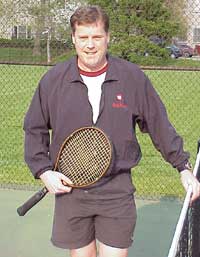Evolution of the Two-Handed Backhand: Part 1
Brian Gordon, PhD
Introduction
Tennis enthusiasts have witnessed several apparent changes in the mechanics of the two-handed backhand (BH2) for decades now. The question is whether these changes represent a systemic evolution or simply individual refinements to the fundamental mechanical attributes that have existed since the beginning.
The beginning is not entirely clear. There is evidence of players using it in some tactical situations as early as the 1930s. Tennis historians indicate that the BH2 became a legitimate primary technique option starting in the 1970s with Chris Evert, Jimmy Connors and Bjorn Borg. Popularity of the technique arguably exploded with the implementation that some consider the greatest BH2 of all time – Andre Agassi (b.1970)
The BH2 has obviously become the dominant form in modern tennis technique. Presumably this is because players can have more success with it at early stages of development (especially on higher contact balls and return of serve) and this drives instructional preference for that demographic. Additionally, with very few notable exceptions on the current professional tours, players winning significant titles use a BH2.
To assess whether the BH2 implementations we witness today represent some systematic evolution of the technique, or individual innovations to the original templates it is useful to define the fundamental types of BH2. In keeping with the theme of this two-part Tennisplayer.net issue, I will then utilize this “type lens” to contrast the mechanics of the old (Agassi) with those of the new (Alcaraz).
BH2 Type Classification
Readers familiar with my approach to stroke assessment may recall that I start by classifying strokes into distinct technical approaches. This was the genesis of the Type I, II, and III definitions for the forehand that some are familiar with. In earlier articles for Tennisplayer I also typed the BH2 (1, 2, 3, 4). Here I will briefly redefine the BH2 types, especially since they have changed (as have the forehand types) based on advancing research.
Stroke typing for the BH2 is based on backswing shape (straight or looped), racquet orientation relative to the hand at the start of the forward swing (inside or outside), and elbow angle of the top arm (bent or straight) in at least the final two-thirds of the forward swing. These attributes are identifiable visually in real time but the inside or outside designation can sometimes be trickier (see Type 3 Defined video below).
Based on these stroke characteristics the following BH2 types are defined:
Type1
Looped backswing with an inside racquet orientation at the start of the forward swing. Referred to as an “inside
loop” the amount of inside deviation can be quite variable – from minimal to massive. This BH2 is most common in
junior tennis and at the collegiate and pro level for females.
Type 2
Straight backswing. It may have an inside (T2I) or outside (T2O) racquet orientation although an inside orientation
is generally a developmental flaw (known as a pre-roll). High level players will nearly always exhibit an outside
orientation. The optimal version T2B includes a flip-straight top arm over most of the forward swing.
Type 3
Looped backswing with an outside racquet orientation. Referred to as a “hook loop” the size of the loop is variable.
An argument could be made that this is the most prevalent BH2 on the ATP tour including now the Type 2 poster boy
Djokovic. The optimal version T3B includes a flip-straight top arm over most of the forward swing.
Type 3 (Re)Defined
The Type 3 designation was redefined roughly five years ago. The old Type 3 became the Type 2. Since I’ve not written on the BH2 for Tennisplayer for several years, the concepts may not be familiar to readers. Therefore, it may be useful in the context of this article to define the basic attributes. The following video is a basic description of the elements, but should assist in understanding the BH2 strokes discussed in this article.
So, that’s it for part one. Stay tuned for part two in the next issue, where based on the new framework, I’ll classify Agassi and Alcaraz BH2s.




